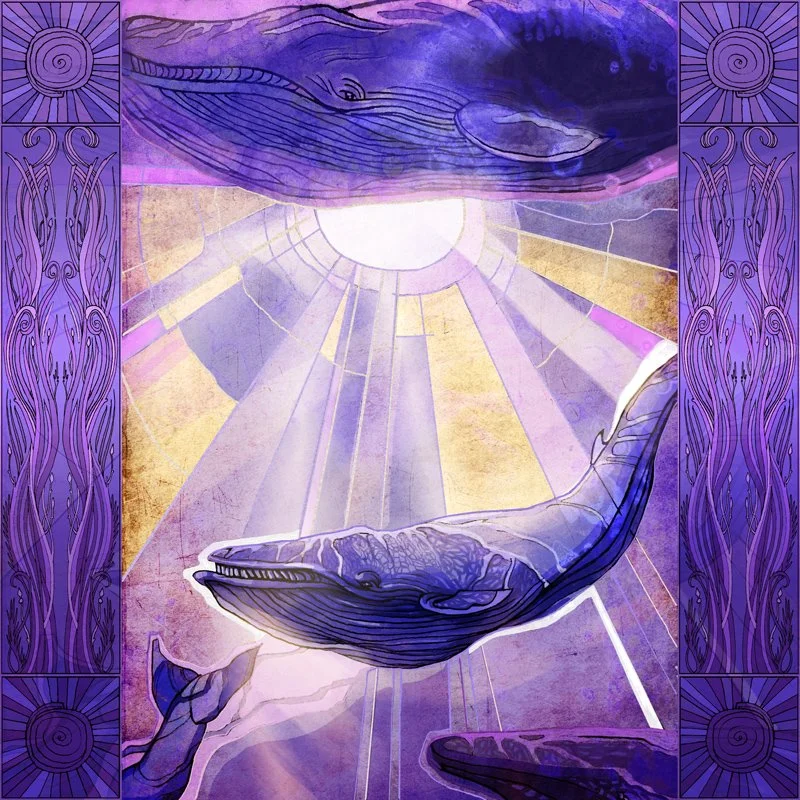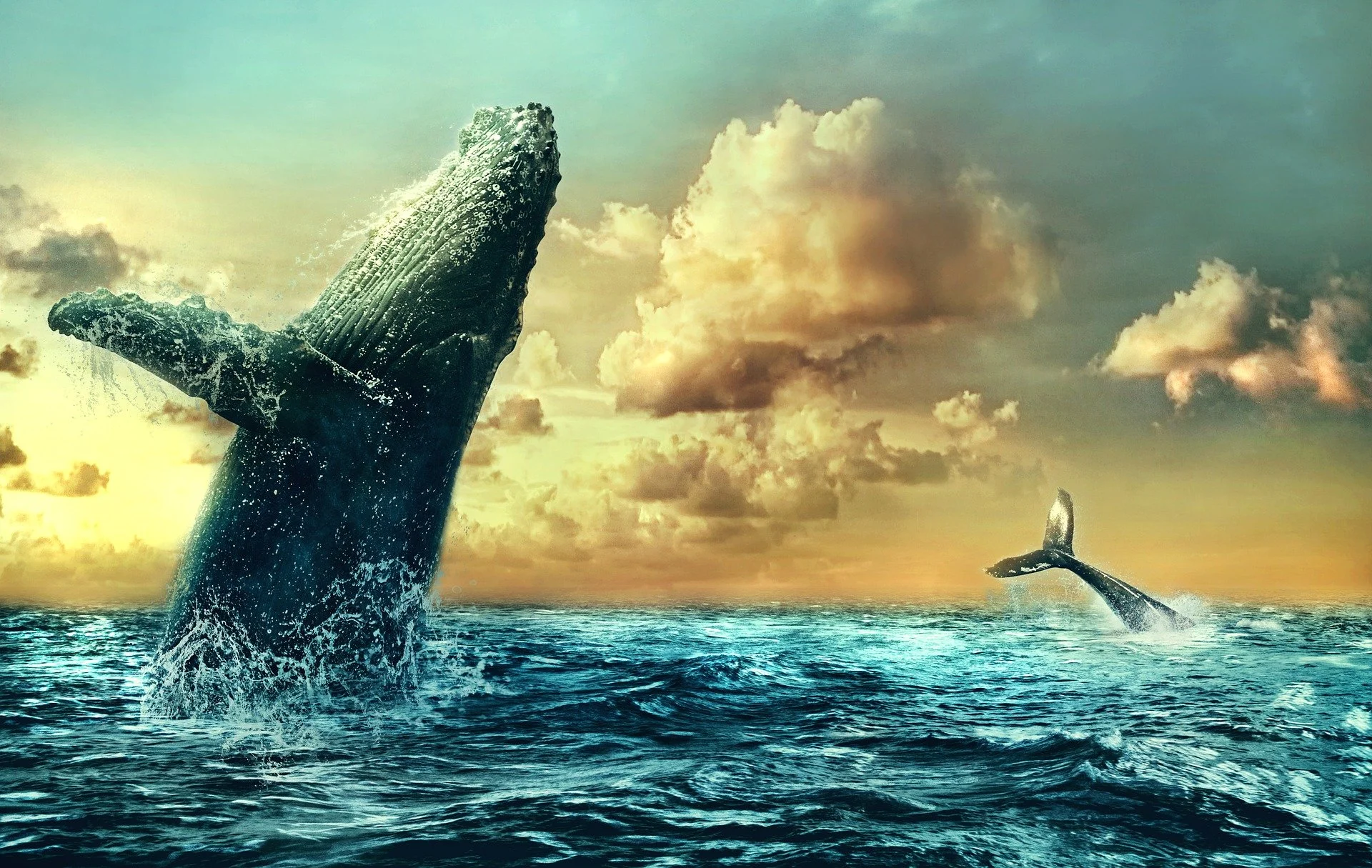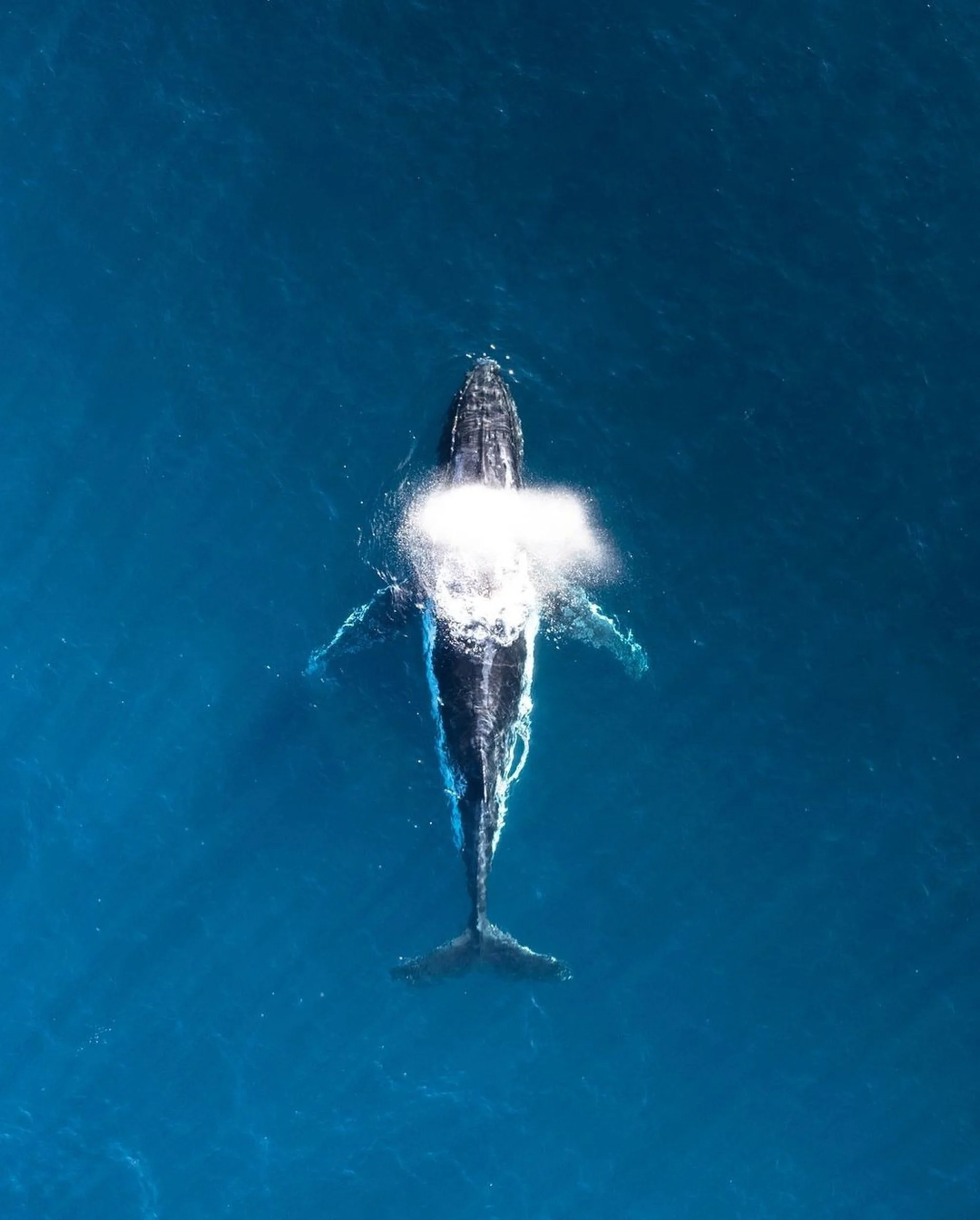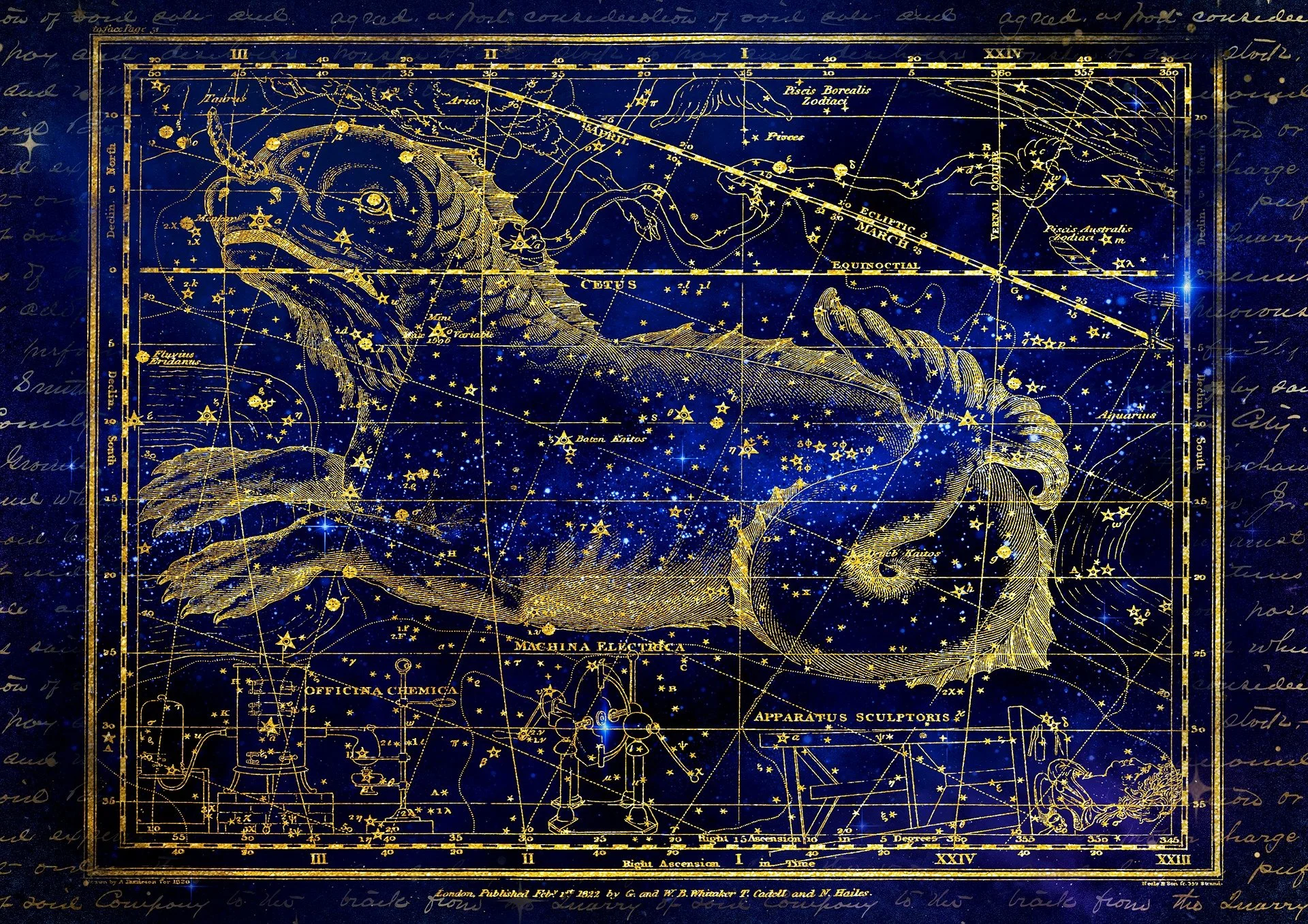Whale Symbolism in Ancient Stories and Cultures: A Journey of Initiation and Transformation
The Wondrous World of Whales: Self-Awareness, Empathy, and Communication
(Art by yanadhyana on DeviantArt)
Whales possess brain structures analogous to our own, including the development of spindle cells, which are linked to crucial functions such as self-awareness, empathy, and communication. As a result, these majestic creatures can recognize one another, develop deep bonds, and identify themselves and their companions.
In addition, their incredible journeys to their breeding grounds involve the courting and mating of partners and the nurturing of their offspring through milk production. Whales exhibit remarkable ingenuity by creating and utilizing tools, engaging in play and exploration, and even engaging in forms of education and cooperation.
In moments of grief and loss, they have been known to mourn the passing of their fellow whales. And when their minds wander into the realm of sleep, they are believed to dream just as we do. Indeed, whales are creatures of profound intelligence and emotional depth, worthy of our admiration and respect.
Whale Symbolism in Mythology
Once considered a fish, the whale has been a central figure in many ancient stories worldwide. The theme of death and rebirth associated with this majestic creature can be found in diverse cultures ranging from Japan and Vietnam to Polynesia and Finland, a testament to its enduring power as a symbol of initiation and transformation.
(Image from Pixabay)
In mythology, whales are revered as the spirits of the deep, embodying the mysteries of the unconscious, the night, the womb, and the Underworld. Our ancestors once referred to these majestic creatures as dragons, sea monsters, and gigantic fish, projections that reveal our primal fears of becoming lost in the vastness of the universe.
Even the cosmos bears witness to the awe-inspiring nature of these creatures, as the constellation Cetus, or the Whale, takes shape in the depths of the spatial abyss. Its form, a reflection of the fluid and graceful movements of these giants of the sea, serves as a constant reminder of the majesty and power that whales hold over our imaginations.
The Night Sea Journey Myth and the Whale
The Night Sea Journey tells the tale of a solar hero who becomes confined within the belly of a whale. This event serves as a metaphorical representation of the hero's journey toward inner transformation.
In his insightful depiction of this myth, Carl Jung proposes the powerful ritual of katabasis, a Greek term signifying a gradual descent. This descent takes the form of a journey to the Underworld, where the hero searches for renewal, rebirth, and regeneration.
Whale Symbolism in the Bible: Jonah and the Whale
(Image from Picryl)
The Bible holds the mighty and majestic whale in high regard, with one of its most legendary accounts centered around this remarkable creature.
The Book of Jonah tells the story of a divine commandment that requires the prophet to journey to the city of Nineveh and warn its people of the sinful path they tread, with dire consequences if they refuse to repent. Jonah struggles with the notion of human redemption. He ultimately disobeys the directive, embarking on a defiant voyage to sea with his crew.
As the group is caught in a ferocious storm, Jonah perceives it as a manifestation of God's wrath. So, in a desperate attempt to appease the wrath of the divine, the sailors threw Jonah overboard, where he was swallowed whole by a giant "fish."
In a desperate attempt to appease the wrath of the divine, the sailors threw Jonah overboard, where he was swallowed whole by a giant "fish."
For three long days and nights, Jonah found himself confined within the belly of the whale, an experience that brought him to the brink of despair. But amid this darkness, Jonah courageously embraced his duty and delivered the prophecy. He emerged from the whale's belly, reborn and transformed.
Jonah portrayed the whale's insides as sheol, meaning "the pit," the place of darkness where the dead go. The whale's cavernous jaws, in turn, symbolize the gates of hell. In contrast, the belly of the whale serves as a womb, birthing Jonah anew into a life of purpose and meaning. Thus, the story of Jonah and the whale serves as a powerful reminder of the transformative power of confronting our deepest fears and emerging reborn into a new life.
Whale Symbolism in Islam
Within the Islamic faith, there is a profound belief that the majestic whale is a critical cornerstone to the very foundation of the Universe. With unparalleled size and strength, the whale provides an awe-inspiring base upon which a mighty bull stands, holding up a massive green rock of remarkable significance. Perched atop this hallowed stone rests an angel, tasked with supporting the earth. Such is the delicate balance of the natural world that, should the whale begin to tremble, the planet's equilibrium would be thrown perilously off-balance, leading to the tumultuous upheaval of earthquakes.
Whale Symbolism in Inuit Traditions
In the Tikigaq (Tikigagmiut) Inuit culture, the whale is more than just a creature of the sea; it is a cunning trickster. According to a well-known myth, the belly of the whale held a magnificent abode furnished with elegance and splendor, where a beautiful woman lived. This area, created by the reassembled whalebones, was believed to be a place of birth and death and a site of immense danger and initiation.
On rare occasions, the mysterious woman would extend her gracious hospitality to mariners, most likely to offer comfort and solace to the seafarers of this powerful whaling culture, who regularly faced the perils of the ocean.
Whale Symbolism in Indigenous Pacific Northwest Coast Traditions
With graceful movements and deep reverence, the Kwakwaka'wakw (Kwakiutl) shaman donned a magnificent work of art upon his head and back - an exquisite whale mask meticulously crafted to come alive with each swaying step as an integral part of the ceremonial winter dances.
Whale Symbolism in Indigenous Australian Cultures: Gyian the Whale
In the lore of Australia, a tale of great significance speaks of a majestic whale known as Gyian. Long before the world as we know it came to be, the creator Baiyami dwelled amongst the shimmering stars of the Milky Way. He fashioned the plants and animals that now thrive on our earth with his divine power.
Among his many masterpieces, Baiyami's heart was captivated by the gentle spirit of Gyian, the magnificent whale. Filled with affection, Baiyami vowed to create a world of perfect harmony where Gyian could dwell and flourish. And so, he brought Gyian and Bunder, the noble kangaroo, into this new world and declared it as Gyian's dreaming place.
Whale Symbolism in Māori Traditions: The Whale Rider
(Image from Unsplash)
The tale commences with the half-brothers Kahutia-te-rangi and Ruatapu. Ruatapu, who already harbored resentment towards Kahutia-te-rangi due to his higher status, planned to take revenge when their father, Uenuku, scolded him for using Kahutia-te-rangi's comb without permission.
Ruatapu built a canoe and invited Kahutia-te-rangi and other high-ranking sons of Uenuku into it, pretending to take them on a sea voyage. However, unknown to the young men, Ruatapu had made a hole in the canoe's bottom, which he temporarily clogged with his heel. Once far away from the shore, he removed his heel, causing the canoe to sink.
After that, Ruatapu drowned every young man except for Kahutia-te-rangi, who recited an incantation that summoned the Southern humpback whales, known as "paikea" in Maori, to help him reach the shore. The whales came to his aid, carrying Kahutia-te-rangi to safety and making him the only survivor of the tragedy. In honor of the whales that saved his life, Kahutia-te-rangi assumed the name Paikea.
Whale Symbolism in Hawaiian Culture
In the eyes of Hawaiians, the whale embodies Kanaloa, the God of the ocean, in the form of an animal. These majestic creatures are regarded as guardians and deeply connected to the divine and spiritual realm. Hawaiians consider the body of a whale to be sacred. If one happens to wash ashore, they show great reverence to the ground upon which it lies. Alii, chiefs, and Kahuna, spiritual leaders, are appointed to protect and honor the site where the whale rests.
Whale Symbolism in Vietnamese Culture
Vietnamese culture honors the whale as a revered guardian and protector of fishermen. Known as Cá Ông or Lord Fish, the whale is considered a divine creature in Vietnam. The Vietnamese celebrate the whale by building temples dedicated to it and holding intricate funerals for any whales that wash up on shore. In addition, the whale's bones are respectfully placed in a temple as a symbol of the whale's significance to Vietnamese culture.
Whale Symbolism in Ancient Greek Mythology
The Sea Creature: Aspidochelone
In Greece, a sea creature is known as aspidochelone, or in Latin, "asp-turtle," which is believed to be a massive whale with beaches on its hide, resembling those found on the shore. The creature often raises its back above the sea waves, creating an illusion that it is an island. Unsuspecting sailors may mistake it for a sandy beach and beach their ship alongside it, only to discover their grave mistake. Once they disembark and set up camp, the monster submerges into the water, taking the ships and its crew down into the depths of the sea.
Cetus and Andromeda
(Image from Pixabay)
In Greek mythology, Poseidon, the sea god, was linked to a whale or sea monster known as Cetus. The tale tells of Queen Cassiopeia of Ethiopia, and her daughter, Andromeda, whose beauty Cassiopeia bragged was superior to that of Poseidon's sea nymphs, the Nereids.
Poseidon, furious at this boastfulness, dispatched Cetus to attack Ethiopia. Fearful of the monster, Cassiopeia resolved to offer Andromeda as a sacrifice, chaining her to a rock near the ocean. But before Cetus could harm her, Perseus arrived, wielding Medusa's head, turning Cetus to stone. Distraught at the loss of his sea creature, Poseidon cast the petrified Cetus into the sky, where it became a constellation.
Whale Symbolism in Norse Mythology
The Vikings had their version of the whale myth, featuring Lyngbakr, a creature disguised as an island that lured sailors to their doom. Despite their fear of these beasts, the ancient Scandinavians still hunted them for sustenance.
In one tale from the Heimskringla sagas, King Harald of Denmark sends his warlock to Iceland for reconnaissance. The warlock shapeshifts into a whale to make the journey. Still, no matter where he travels along the coast, he is thwarted by Icelandic guardian spirits. Ultimately, the king is forced to abandon his plan to attack Iceland.
Inviting the Whale Within
The spiritual significance of whales emanates from myths and folklore that depict them as swallowing humans wholly. This has led to the whale symbolizing completion, entombment, and the body. Additionally, whales represent the connection between the divine and ordinary worlds, as whales surface from the sea and descend to its depths, embodying the inner world and the unconscious.
Moreover, interpretations of dreams are subjective and unique to each individual dreamer. Nonetheless, gaining knowledge about whales and their cultural significance and being open and curious about the emotions felt during the dream may provide a more profound understanding of its meaning.
What personal meaning do you attach to the symbolism of the whale?
How has the whale appeared in your life, and what significance do you give to these encounters?
Have you encountered the whale in your dreams, and if so, what message might it be trying to convey?
Warmly,
Anny
Art by Art by yanadhyana on DeviantArt⠀
References used:
Martin, K., & Ronnberg, A. (2010). The book of symbols: Reflections on archetypal images.
Wilkinson, P. (2014). Signs & Symbols: An illustrated guide to their origins and meanings. Metro Books.





